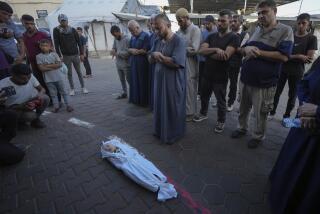Masterminding the Movement of the Wounded : Hospitals: Computers help a U.S. military office in Germany route the sick and injured to sites throughout Europe.
FRANKFURT, Germany — A red-haired man in battle dress sits at a computer terminal here doing the mathematics of medical evacuation, masterminding the movement of the sick and wounded from the Persian Gulf War to hospitals across Europe.
U.S. Navy Lt. Cmdr. Gene Barron is a kind of air traffic controller for military medicine, a travel agent to the infirm and even mortally injured. His mission is considered crucial to the smooth running of war. Do it badly and the merely wounded could end up dead.
These days, Barron’s office handles 60 to 100 patients a day, moving them out of treatment facilities in Saudi Arabia to beds in hospital wards in Europe. But if a ground war breaks out, he and his staff could find themselves juggling up to 30 times that many.
“Because of the marvel of automation and retrieval, you could do several thousand a day,” said Barron’s boss, Army Col. James M. Tyler, chief of operations and logistics for the European Command surgeon’s office. “But his hair’s going to be as gray as mine when he does it.”
In an interview here this week, Tyler said the military’s capacity in Europe to care for the injured has swelled recently to “10,000 beds I could tap right now,” in part through a growing number of agreements with European countries offering space in their own military and civilian hospitals.
German medical “regulators,” doing work like that of Barron, are already ensconced in an office down the hall with computer access to available beds in German hospitals. Denmark and Spain are making similar arrangements, and the United States has received offers from other so-called host nations, Tyler said.
“When we planned this, we planned a worst-case scenario, if you will,” Tyler said. “We determined the number of beds we needed, and we have those beds. And then the nice cushion is, when all the host nations come on line, that made our lives much easier.”
Under current plans, all patients evacuated from Saudi Arabia are to come through European hospitals, even if only briefly while en route to the United States. They are flown in, many of them on litters, on vast troop and cargo carriers to one of five air bases in Germany and England.
From there, they must be taken by ambulance, bus or helicopter to any of a growing number of hospitals and medical facilities--from the large Army and Air Force hospitals at Frankfurt and Wiesbaden to smaller U.S. military facilities to civilian hospitals throughout Europe.
Their route from Saudi Arabia to a European hospital is plotted by Barron and his staff in the cramped quarters of the Joint Medical Regulating Office at Rhein-Main Air Base here. The regulators work out on computers a complex calculus of air flow, flight time, available beds and specialized medical skills.
“This is a tremendous coordinating system,” said Barron, who came to the job just one week before Iraq invaded Kuwait. “You worry about the people, the hours they’re working, the patients that are coming in, that they’re regulated correctly, that they get to their destination in time.”
The work is not without surprises:
Not long ago, a planeload of what Barron referred to as “terminally pregnant” women materialized on a runway at Rhein-Main. They turned out to be dependents of U.S. military and State Department personnel suddenly evacuated from a U.S. military hospital in Turkey and needing a place to deliver.
Then there was the Saudi prince delivered by ambulance to the Army hospital at Landstuhl. “I get a phone call: ‘What the hell is this Arab doing in the hospital?’ ” recalled Tyler. Only hours later did he learn that the State Department was sending the man to North Carolina for a lung transplant.
Undignified as it seems, the computer reduces each patient to a statistic, like luggage. Each is placed in one of 12 categories of medical care. Barron’s job is to match, say, 10 orthopedic or burn cases coming into Europe for treatment with hospitals able to provide it.
To do that, he and his staff pore over reports from dozens of hospitals in the U.S. and German systems. They then notify the chosen hospitals. Before each patient is loaded on a plane, a tag is attached to his or her clothing to show the patient’s diagnosis, medical need and destination.
If one hospital becomes overloaded, its staff will risk burnout. If another is neglected, skills go untapped. If patients are wrongly routed, they could end up languishing for hours in a temporary holding area or facing a bumpy two-hour ambulance ride on snow-covered roads.
“The capacity is not unlimited, but it more than satisfies anything we could ask,” Tyler said this week, as the prospect of a ground war loomed. “I guarantee it.”
More to Read
Sign up for Essential California
The most important California stories and recommendations in your inbox every morning.
You may occasionally receive promotional content from the Los Angeles Times.










